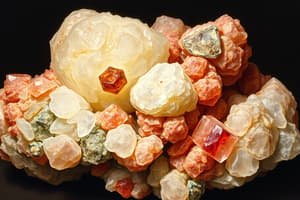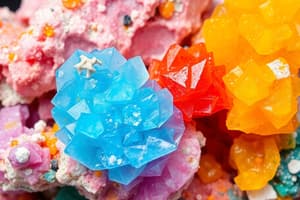Podcast
Questions and Answers
What is mineral classification?
What is mineral classification?
- Grouping minerals by their location
- Grouping minerals by their chemical composition (correct)
- Grouping minerals by their color
- Grouping minerals by their luster
What are native elements?
What are native elements?
Consists of one single element; examples include gold and graphite.
What do halides consist of?
What do halides consist of?
A metal + halogen (Cl, F, Br).
What do carbonates consist of?
What do carbonates consist of?
What do sulfides consist of?
What do sulfides consist of?
What do sulfates consist of?
What do sulfates consist of?
What do oxides consist of?
What do oxides consist of?
What are silicates known for?
What are silicates known for?
What is the silica tetrahedron?
What is the silica tetrahedron?
What are ores?
What are ores?
What does mineralogy study?
What does mineralogy study?
What is fracture in minerals?
What is fracture in minerals?
What does streak refer to in minerals?
What does streak refer to in minerals?
What does hardness refer to in minerals?
What does hardness refer to in minerals?
What is the acid test?
What is the acid test?
What is cleavage in terms of minerals?
What is cleavage in terms of minerals?
What is color in minerals?
What is color in minerals?
What does luster refer to in minerals?
What does luster refer to in minerals?
What is Moh's scale?
What is Moh's scale?
What mineral cleaves in two directions?
What mineral cleaves in two directions?
What mineral cleaves in one direction?
What mineral cleaves in one direction?
What minerals cleave in three directions?
What minerals cleave in three directions?
What are the properties of common minerals?
What are the properties of common minerals?
What is clay in terms of minerals?
What is clay in terms of minerals?
Flashcards are hidden until you start studying
Study Notes
Mineral Classification
- Minerals are organized into groups based on chemical composition.
- Major groups include native elements, halides, carbonates, sulfides, sulfates, oxides, and silicates.
Native Elements
- Comprised of a single element.
- Examples include gold and graphite.
Halides
- Formed from a metal and a halogen element (Cl, F, Br).
- An example is fluorite.
Carbonates
- Consist of a metal combined with a carbonate group (CO3).
- Key examples are calcite and dolomite.
Sulfides
- Comprise a metal and sulfur.
- Notable examples include galena and pyrite.
Sulfates
- Formed from a metal and a sulfate group.
- Example mineral is gypsum.
Oxides
- Consist of a metal combined with oxygen.
- Hematite and magnetite are common examples.
Silicates
- The largest and most common mineral family.
- Basic structural unit is the silica tetrahedron, consisting of silicon and oxygen.
- Common minerals include quartz and olivine.
Silica Tetrahedron
- Formed by four oxygen ions surrounding a smaller silicon ion.
Ore
- Minerals that possess commercial value and can be economically extracted.
- Lead is an example of an ore.
Mineralogy
- The scientific study that focuses on minerals.
Fracture and Cleavage
- Fracture refers to uneven splitting of a mineral.
- Cleavage describes a mineral breaking along flat surfaces or planes.
Streak
- The color of the powder produced by scratching a mineral against a surface.
Hardness
- Indicates a mineral’s resistance to scratching.
- Moh's scale is utilized to rank hardness levels.
Acid Test
- Involves dropping hydrochloric acid on a mineral to check for bubble formation.
Color
- Easy to observe but unreliable for mineral identification.
Luster
- Describes how a mineral reflects light, categorized as either nonmetallic or metallic.
Cleavage Directions
- Feldspar breaks in two directions.
- Muscovite cleaves in one direction.
- Halite and calcite each cleave in three directions.
Essential Properties of Common Minerals
- Characteristics to consider include luster, common colors, cleavage/fracture patterns, uses, and composition.
Clay
- Identified as a mineral source located closest to Valhalla.
Studying That Suits You
Use AI to generate personalized quizzes and flashcards to suit your learning preferences.




